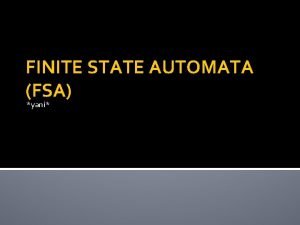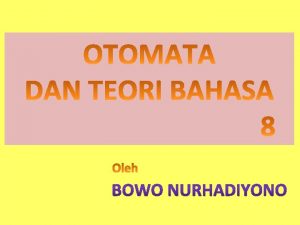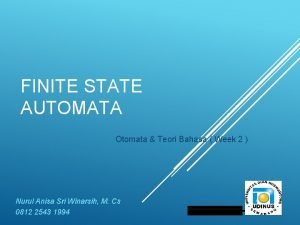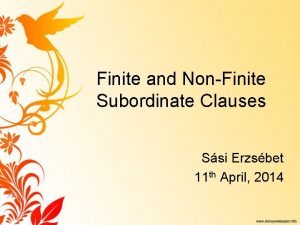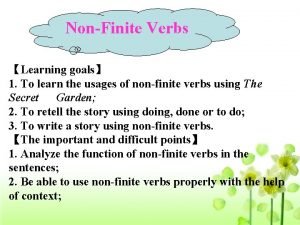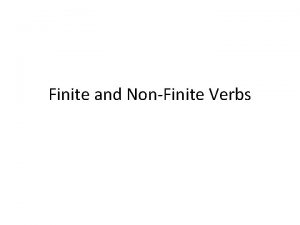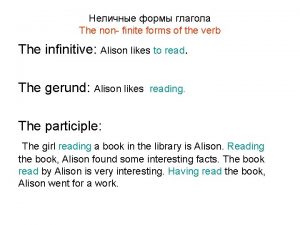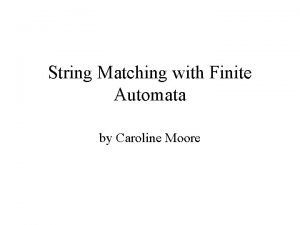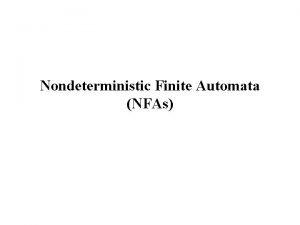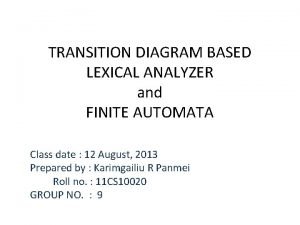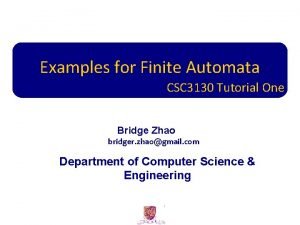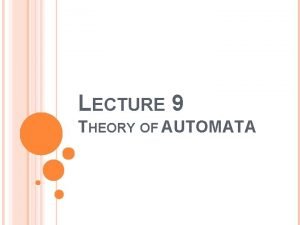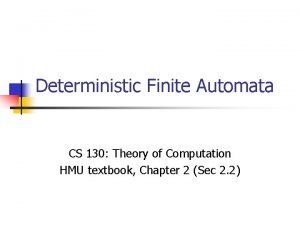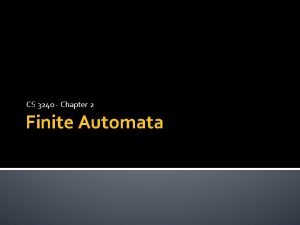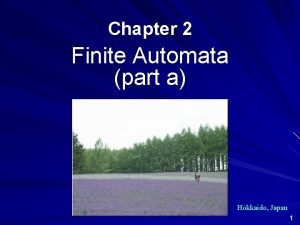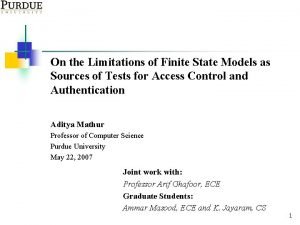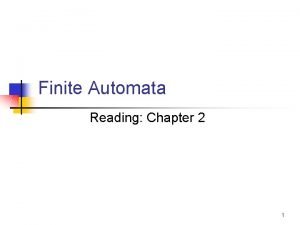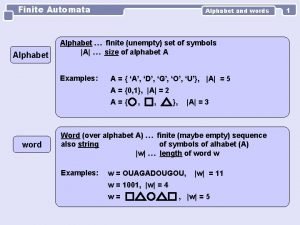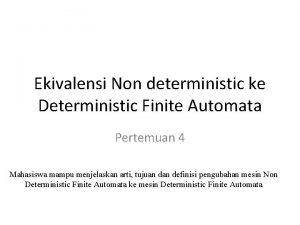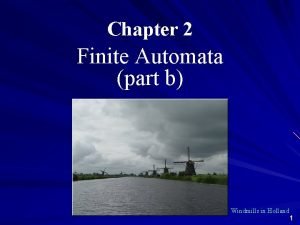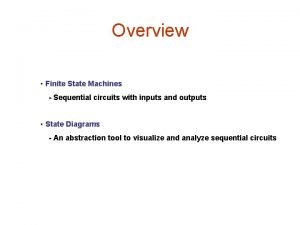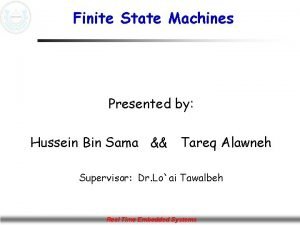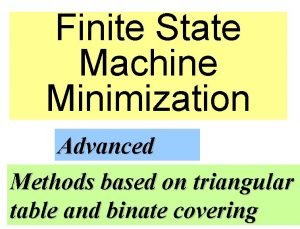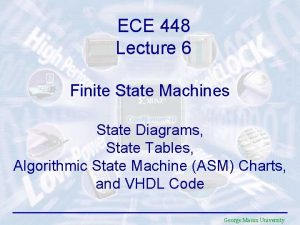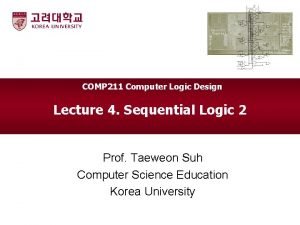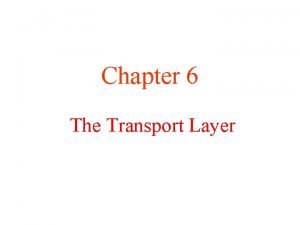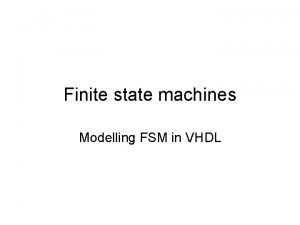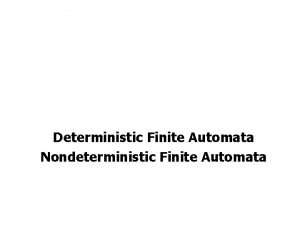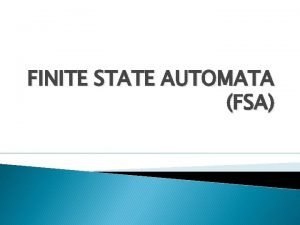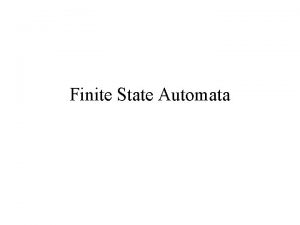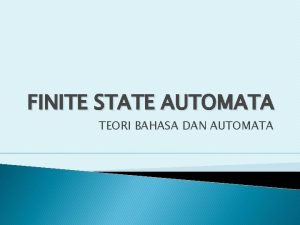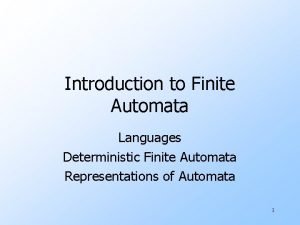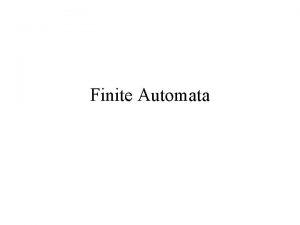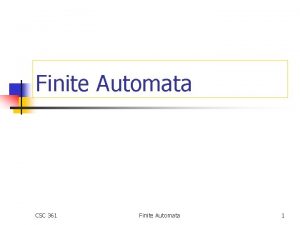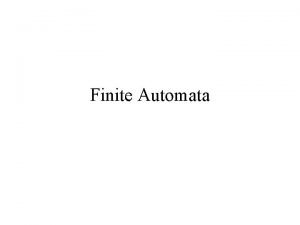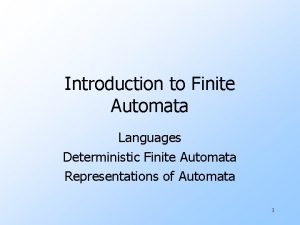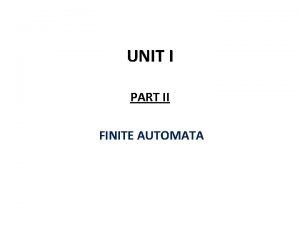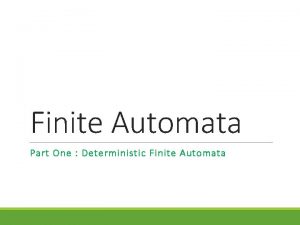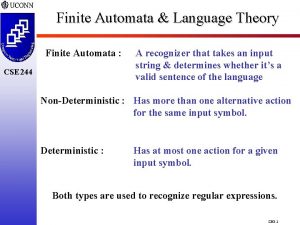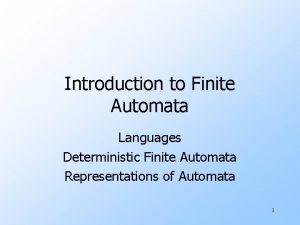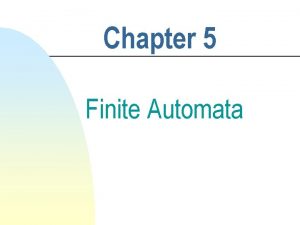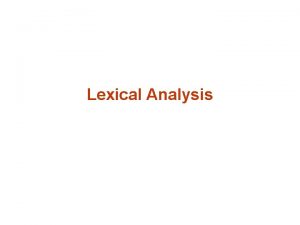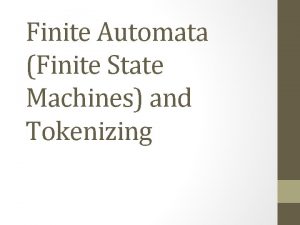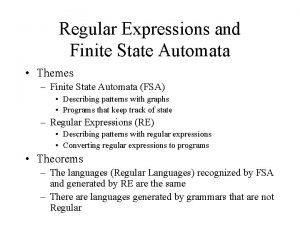Summary Summary Automata Finite Automata single start state




































- Slides: 36

Summary

Summary Automata

Finite Automata (single) start state 1 states 0 0, 1 alphabet Σ = {0, 1} (several) accept states transition for each symbol 0, 1 n read input one symbol at a time; follow arrows; accept if end in accept state

Finite Automata n n Non-deterministic variant: NFA Regular expressions built up from: ¡ ¡ ¡ unions concatenations star operations Main results: same set of languages recognized by FA, NFA and regular expressions (“regular languages”).

Pushdown Automata finite control input tape 0 1 1 0 0 1 q 0 New capabilities: (infinite) stack 0 1 1 0 : • can push symbol onto stack • can pop symbol off of stack

Context-Free Grammars terminal symbols start symbol A → 0 A 1 A→B B→# production non-terminal symbols

n CFL-> PDA n PDA-> CFL

Pushdown Automata Main results: same set of languages recognized by NPDA, and contextfree grammars (“context-free languages”). L (P)? N(P)? n n and DPDA’s weaker than NPDA’s… again, L (P)? N(P)?

Non-regular languages Pumping Lemma: Let L be a regular language. There exists an integer p (“pumping length”) for which every w L with |w| p can be written as w = xyz such that 1. 2. 3. for every i 0, xyiz L , and |y| > 0, and |xy| p. Reason?

Pumping Lemma for CFLs CFL Pumping Lemma: Let L be a CFL. There exists an integer p (“pumping length”) for which every w L with |w| p can be written as w = uvxyz such that 1. 2. 3. for every i 0, uvixyiz L , and |vy| > 0, and |vxy| p. Reason?

Summary Turing Machines and decidability

Turing Machines input tape finite control q 0 n 0 1 1 0 0 1 1 1 0 0 read/write head New capabilities: ¡ ¡ ¡ infinite tape can read OR write to tape read/write head can move left and right …

Deciding and Recognizing • accept n TM M: ¡ ¡ input machine • reject • loop forever L(M) is the language it recognizes by final state if M rejects every x L(M) it decides L set of languages recognized by some TM is called Turingrecognizable or recursively enumerable (RE) set of languages decided by some TM is called Turingdecidable or recursive

n Extension ¡ Multiple track Multiple tape State with Buffer Nondeterministic ¡ 。。。 ¡ ¡ ¡

The Halting Problem n Definition of the “Halting Problem”: HALT = { <M, x> | TM M halts on input x } n Is HALT decidable?

The Halting Problem Theorem: HALT is not decidable (undecidable). Proof: ¡ Suppose TM H decides HALT n n ¡ Define new TM H’: on input <M> n n ¡ if H accepts <M, <M>>, then loop if H rejects <M, <M>>, then halt consider H’ on input <H’>: n n ¡ if M accept x, H accept if M does not accept x, H reject if it halts, then H rejects <H’, <H’>>, which implies it cannot halt if it loops, then H accepts <H’, <H’>>, which implies it must halt contradiction. Thus neither H nor H’ can exist

H’ is the opposite of the diagonals: n Entry i, j is the value of H on input <Mi, <Mj>> <M 1> <M 2> <M 3> <M 4> … M 1 M 2 M 3 M 4 … H’ A A R A R A A A R R R R A A <H’> ?

Decidable, RE, co. RE… co-HALT {anbn : n ≥ 0 } co-RE decidable some language regular languages all languages context free languages RE {anbncn : n ≥ 0 } HALT some problems (e. g HALT) have no algorithms

Definition of reduction A yes no f f yes no B reduction from language A to language B

Using reductions n Used reductions to prove lots of problems were: ¡ ¡ undecidable (reduce from undecidable) non-RE (reduce from non-RE) n ¡ non-co. RE (reduce from non-co. RE) n n or show undecidable, and co. RE or show undecidable, and RE Reduction Direction!

Summary Complexity

Complexity n Complexity Theory = study of what is computationally feasible (or tractable) with limited resources: ¡ ¡ ¡ running time storage space number of random bits degree of parallelism rounds of interaction others… main focus not in this course

Time and Space Complexity Definition: the time complexity of a TM M is a function f: N → N, where f(n) is the maximum number of steps M uses on any input of length n. Definition: the space complexity of a TM M is a function f: N → N, where f(n) is the maximum number of tape cells M scans on any input of length n.

Complexity Classes Definition: TIME(t(n)) = {L : there exists a TM M that decides L in space O(t(n))} P = k ≥ 1 TIME(nk) EXP = k ≥ 1 k n TIME(2 ) Definition: SPACE(t(n)) = {L : there exists a TM M that decides L in space O(t(n))} PSPACE = k ≥ 1 SPACE(nk)

Complexity Classes Definition: NTIME(t(n)) = {L : there exists a NTM M that decides L in time O(t(n))} NP = k ≥ 1 NTIME(nk) n n n Theorem: P EXP P NP PSPACE EXP Don’t know if any of the containments are proper.

Poly-time reductions n Type of reduction we will use: ¡ ¡ A “many-one” poly-time reduction (commonly) “mapping” poly-time reduction (book) yes no f f yes no 1. f poly-time B computable 2. YES maps to YES 3. NO maps to NO

Hardness and completeness Definition: a language L is C-hard if for every language A C, A polytime reduces to L; i. e. , A ≤P L. can show L is C-hard by reducing from a known C-hard problem Definition: a language L is C-complete if L is C-hard and L C

Complexity classes EXP P co. NP PSPACE decidable languages NP

Decidability and Closure Property

n RL n Parallel Production n CFL n Clean、CYK n TM Construction

n Closure Property n Use known statement to Prove unknown argument n Closure of complexity class n Consider operation between languages in different classes

Models

n Transition System ¡ ¡ Semantic Basis Definition Equivalence Temporal Logic

n Petri Net ¡ ¡ Concurrency Token Game Model a concurrency System Relation Between PN and TS

n Timed Automata Definition ¡ ¡ ¡ Continuous time domain When should we use such model? Invariant, Guard, Reset? Model a real system!

Recruitment n bulei@nju. edu. cn n No. 308, CS Building n 2 Positions left
 Soal teori bahasa dan automata
Soal teori bahasa dan automata Finite automata dikelompokkan menjadi
Finite automata dikelompokkan menjadi Finite state automata didefinisikan dengan
Finite state automata didefinisikan dengan Mesin mealy adalah
Mesin mealy adalah Apa yang dimaksud dengan tata bahasa dan aturan produksi
Apa yang dimaksud dengan tata bahasa dan aturan produksi Deterministic finite state automata
Deterministic finite state automata Contoh kasus finite state automata
Contoh kasus finite state automata Finite and non finite subordinate clauses
Finite and non finite subordinate clauses What is finite verb
What is finite verb Learning objectives of non finite verbs
Learning objectives of non finite verbs Finite and non-finite verb
Finite and non-finite verb Finite and non finite
Finite and non finite String matching with finite automata
String matching with finite automata Finite automata
Finite automata Lexical analysis finite automata
Lexical analysis finite automata Transition diagram in automata
Transition diagram in automata Automata
Automata Kleene theorem part 3
Kleene theorem part 3 Theory of computation
Theory of computation Finite automata
Finite automata An informal picture of finite automata
An informal picture of finite automata Limitations of finite state machine
Limitations of finite state machine Finite automata
Finite automata Finite automata
Finite automata Unempty
Unempty Deterministic finite automata adalah
Deterministic finite automata adalah Finite automata with epsilon transitions
Finite automata with epsilon transitions Forevers gotta start tonight
Forevers gotta start tonight Jump triage
Jump triage Size of tcp segment header
Size of tcp segment header Finite state machine sequential circuits
Finite state machine sequential circuits Finite state machine with datapath
Finite state machine with datapath Finite state machine minimization
Finite state machine minimization Vhdl finite state machine
Vhdl finite state machine Traffic light finite state machine
Traffic light finite state machine Transport layer primitives
Transport layer primitives Fsm
Fsm


